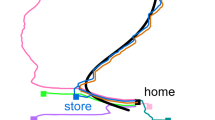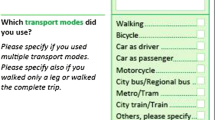Abstract
This paper describes parts of a study of travel by urban residents on seven consecutive days. The conceptual structure of the research understands travel as a demand derived by a dynamic process of individuals and households allocating their budgets to activities within the framework posed by societal regimens. Societal rules have a time dimension which is repetitive with a weekly cycle. Thus, distinctive basic patterns of weekly mobility are expected for segments of the society and differences in the obligation to adhere to those basic patterns. The data used for testing these hypotheses is described and the issue of increasing reporting bias over the diary period is addressed. Sixteen life cycle groups of persons are selected here for the presentation of some findings.
The profiles of trip rates for the groups over the seven days of the week (estimated with analysis of covariance) and the decomposition of the variances of trip rates into interindividual, intraindividual and systematic parts (by repeated measurement analysis) are reported. Characteristic differences in the volume of mobility, the shape of profiles and the variance components reflect different patterns of tripmaking for segments of the population over the week. It is concluded that even for well-defined person categories, interpersonal variety of mobility behavior is large but has to be seen in relation to even greater intrapersonal variability. Both components can best be understood within the period of one week which individuals use to organize their mobility.
Similar content being viewed by others
References
Ben-Akiva ME & Lerman S (1985)Discrete Choice Analysis: Theory and Application to Travel Demand. Cambridge, Mass.: MIT Press.
Hägerstrand T (1970) What about people in regional science:Papers and Proceeding of the Regional Science Association 24: 7–24.
Burnett P & Hanson S (1982) The analysis of travel as an example of complex human behavior in spatially — constrained situations: definition and measurement issues.Transportation Research A: 87–102.
Damm D (1980) Interdependencies in activity behavior.Transportation Research Record 750. Washington, DC: TRB, National Research Council (pp 33–40).
Pas EI (1984) The effect of selected sociodemographic characteristics on daily travel-activity behavior.Environment and Planning A: 571–581.
Hensher DA (1987) Introduction.Transportation Research A: 247–248.
Kitamura R (1989) Guest editorial.Transportation 16: 97–99.
Iida Y & Kitamura R (1990) Editorial.Transportation Research A: 399–400.
Hirsh M, Prashker JN & Ben-Akiva ME (1986) Dynamic model of weekly activity pattern.Transportation Science 13: 24–36.
Pas EI & Koppelman FS (1987) An examination of the determinants of day-to-day variability in individuals' urban travel behavior.Transportation 14: 3–20.
Hanson S & Huff JO (1988) Systematic variability in repetitious travel.Transportation 15: 111–136.
Pas EI (1988) Weekly travel-activity behavior.Transportation 15: 89–109.
Sugie Y & Ashizawa T (1992) Characteristics of weekly travel patterns in a Japanese city. Paper presented at the 6th World Conference on Transport Research, Lyon, July 1992.
Mannering FL (1989) Poisson analysis of commuter flexibility in changing routes and departure times.Transportation Research B: 53–60.
Mahmassani HS (1989) Dynamic models of commuter behavior: Experimental investigation and application to the analysis of planned disruptions. Prepared for presentation at the International Conference on Dynamic Travel Behavior Analysis, Kyoto University, 1989.
Kunert U (1992)Individuelles Verkehrsverhalten im Wochenverlauf. DIW-Beiträge zur Strukturforschung, No. 130. Berlin: Duncker & Humblot.
Heidemann C (1981) Spatial behavior studies: concepts and contexts. In: Stopher PR, Meyburg AH & Brög W (Eds)New Horizons in Travel-Behavior Research. Lexington.
Ministry of Transport (1977)The SIGMO Study—Part 1—Introduction and Summary. Den Haag.
Golob TF & Meurs H (1986) Biases in response over time in a seven-day travel diary.Transportation 13: 163–181.
Kunert U (1992) Weekly travel behavior of urban residents. Paper presented at the 6th World Conference on Transport Research, Lyon, July 1992.
Zimmermann CA (1982) The life cycle concepts as a tool for travel research.Transportation 9: 51–69.
Winer BJ (1971)Statistical Principles in Experimental Design. New York: McGraw-Hill.
Author information
Authors and Affiliations
Rights and permissions
About this article
Cite this article
Kunert, U. Weekly mobility of life cycle groups. Transportation 21, 271–288 (1994). https://doi.org/10.1007/BF01099214
Issue Date:
DOI: https://doi.org/10.1007/BF01099214




